The
Sun
Printable
version
March
20, 2000
Announcements
-
Welcome
back!
-
Homework
#4 on web later today
-
Exams
to be handed back in section this week or early next week
-
Drop
date 3/31 (next Friday)
The
Sun Preview
-
The
Sun's atmosphere
-
Photosphere
-
Chromosphere
-
Corona
-
Sunspots
-
The
Sun's energy source
Sun's
atmosphere
-
The sun is a ball of gas,
no solid surface
-
Solar atmosphere is what
we can see at optical wavelengths
-
From bottom to top:
-
Photosphere
-
Chromosphere
-
Corona
-
From
coldest to hottest:
-
Photosphere
-
Chromosphere
-
Corona
Photosphere
-
What we see when we look
at the Sun (with appropriate filters) NEVER LOOK DIRECTLY AT THE SUN
-
Photosphere is a blackbody
-
Recall: blackbodies aren't
really black, they just don't reflect light
-
Blackbodies emit light
-
The hotter a blackbody, the
higher the energy of the light it emits (shorter wavelength)
-
hotter blackbodies emit more
light
-
Average temperature of photosphere
is 5800 K
-
Sun looks darker toward the
edges (limb darkening)
-
Caused by temperature drop
with altitude in photosphere
-
Association: Earth's lowest
atmospheric layer (troposphere) also gets colder with altitude
-
Close-up view of photosphere
shows granules
-
Each granule is ~1000 km
across
-
Granules caused by convection
(lava lamp effect)
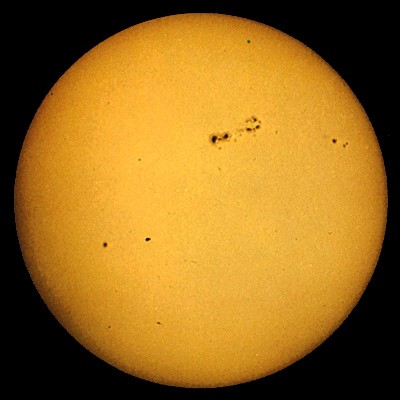
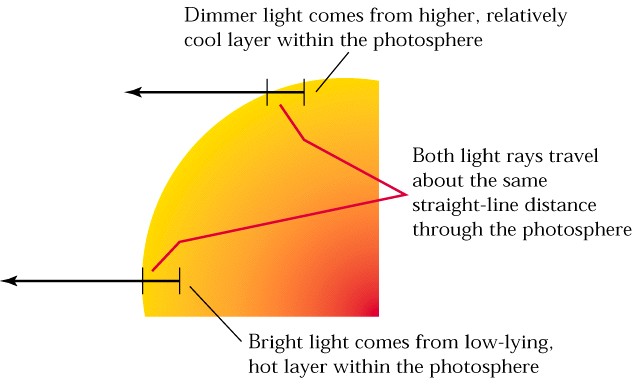
Movie

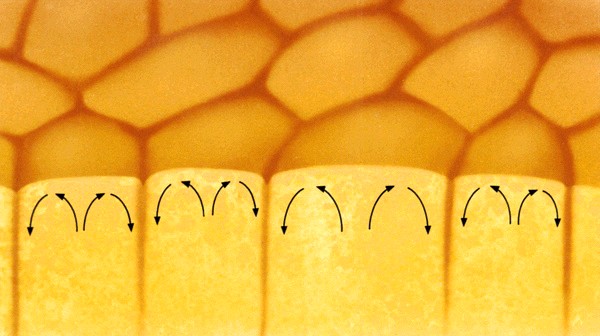
Chromosphere
-
Chromosphere
is hotter than photosphere
-
Has
an emission line spectrum
-
Primary
line is at H-a
at 656.3 nm (red)
-
Much
lower density than photosphere
-
Much
less bright
-
only
visible during eclipse or with special filters
-
Temperature
increases
with altitude in chromosphere
-
association:
stratosphere
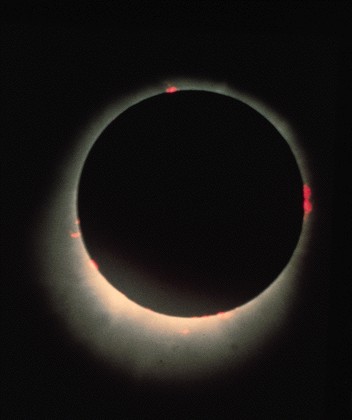
Corona
-
Outermost part of solar atmosphere
-
Least dense part of solar
atmosphere
-
Made up of highly ionized
atoms
-
Beginning of solar wind
-
About as bright as the full
moon
-
Visible with coronagraph
or during lunar eclipse
-
Temperature increases
with altitude
-
cause of increase unknown
-
Corona emits X-rays
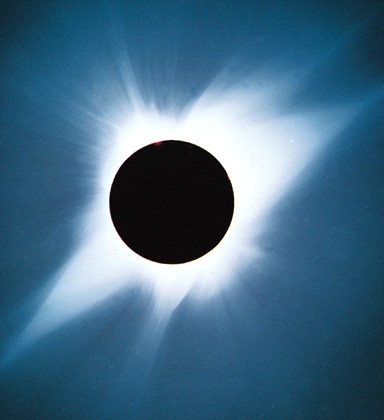
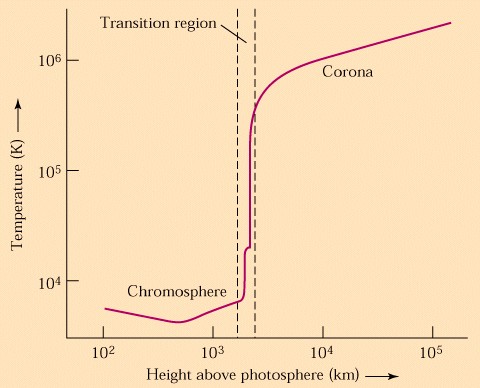
Movie
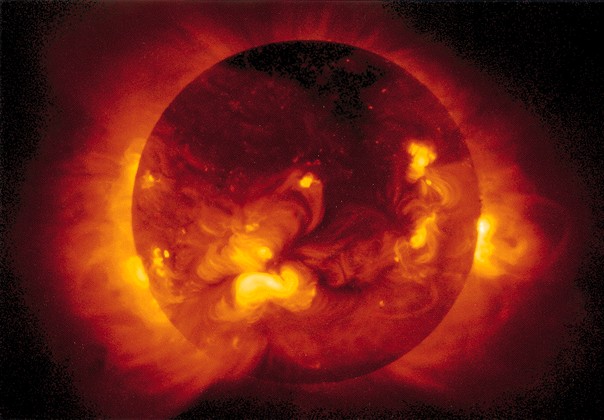
Sunspots
-
Look like flecks of dirt
in on the picture
-
Caused by cool spots in photosphere
-
recall cooler blackbodies
emit less light
-
Galileo observed sunspots
and the rotation of the sun
-
Sun rotates every ~4 weeks
-
Equator rotates faster than
poles!
-
Number of sunspots varies
on an 11 year cycle
-
Even though sunspots are
cooler, the sun as a whole is more active when there are more sunspots
-
Number of sunspots may effect
the weather!

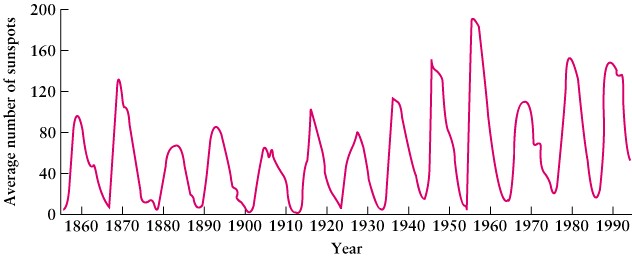
Sunspots
caused by magnetic field
-
Fact: sunspots are sites
of enhanced magnetic fields
-
Fact: sun's magnetic field
reverses poles every 22 years
-
Fact: sunspots appear near
poles and move to equator
-
Theory: Babcock's Magnetic
Dynamo
-
Sun's magnetic field threads
through photosphere
-
Differential rotation winds
field up
-
Convection kinks field, sometimes
forcing it out of photosphere
-
Sunspots happen where magnetic
field leaves photosphere
-
Kinks undone by differential
rotation, moving pairs of sunspots apart
-
Sunspots that congregate
at pole, canceling out and then reversing the Sun's total magnetic field
-
Total cycle takes 22 years,
covering 2 cycles of sunspot activity
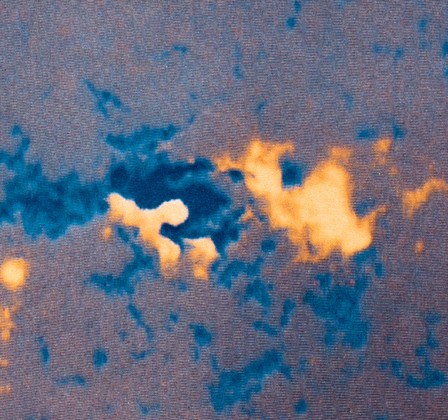

Plages,
Filaments, Flares
-
Chromosphere
has Plages and Filaments near sunspots
-
Filaments
when viewed from the side are called solar prominences (see famous Skylab
picture)
-
prominence
follows magnetic field lines
-
Solar
flares are short-lived, high energy eruptions
-
Causes
burst in solar wind which effects magnetosphere, which disrupts radios,
satellites

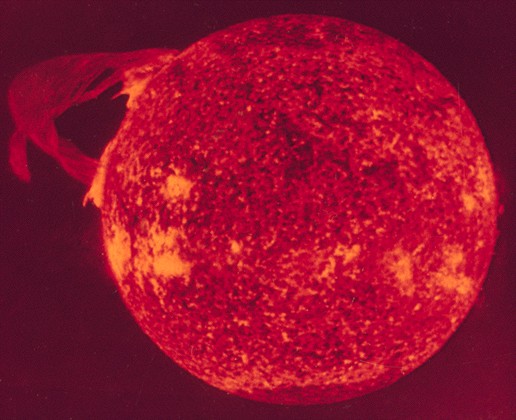
Earth's magnetosphere
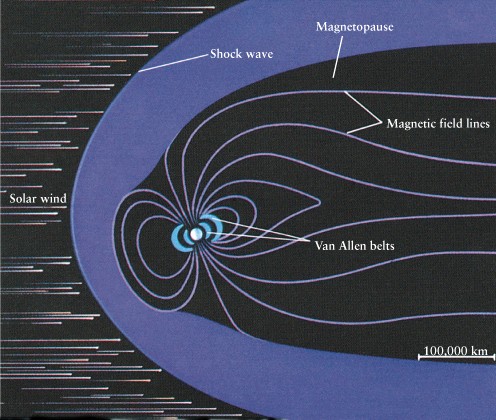
The
Sun's Energy Source
-
Short
answer: Nuclear power (E = mc2)
-
Pressure
in center of Sun is so high, protons (hydrogen nuclei) are pushed together
to form Helium
-
Helium
nucleus has less mass than 4 protons
-
Missing
mass is converted to energy as predicted by Einstein's equation
E
= mc2
lost
m = 0.048 x 10-27 kg
E
= (0.048 x 10-27 kg) x (3 x 108 m/s)2
E
= 4.3 x 10-12 joule
-
Compare
chemical burning: 10-19 joule
-
Nuclear
burning is 10 billion times more efficient than chemical burning
Summary
-
The
Sun's atmosphere
-
Photosphere
-
Chromosphere
-
Corona
-
Sunspots
-
caused
by magnetic field
-
11
year solar cycle
-
magnetic
field reverses every 2 solar cycles (22 years)
-
The
Sun's energy source














